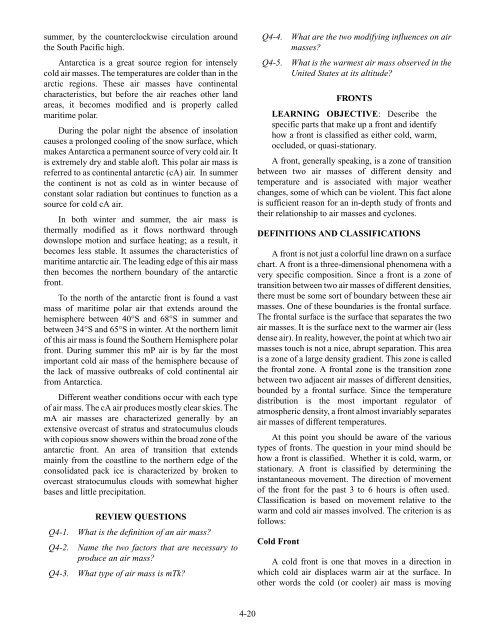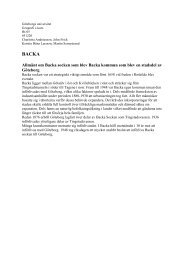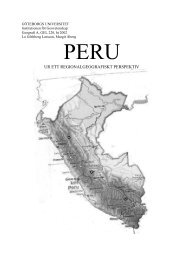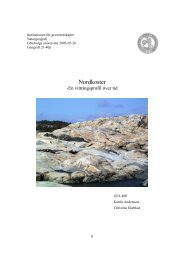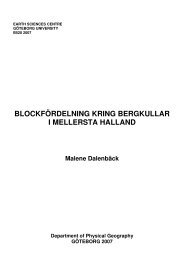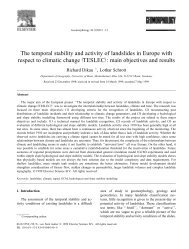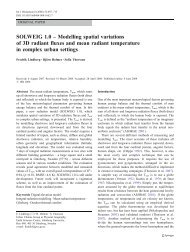AIR MASSES AND FRONTS
AIR MASSES AND FRONTS
AIR MASSES AND FRONTS
You also want an ePaper? Increase the reach of your titles
YUMPU automatically turns print PDFs into web optimized ePapers that Google loves.
summer, by the counterclockwise circulation around<br />
the South Pacific high.<br />
Antarctica is a great source region for intensely<br />
cold air masses. The temperatures are colder than in the<br />
arctic regions. These air masses have continental<br />
characteristics, but before the air reaches other land<br />
areas, it becomes modified and is properly called<br />
maritime polar.<br />
During the polar night the absence of insolation<br />
causes a prolonged cooling of the snow surface, which<br />
makes Antarctica a permanent source of very cold air. It<br />
is extremely dry and stable aloft. This polar air mass is<br />
referred to as continental antarctic (cA) air. In summer<br />
the continent is not as cold as in winter because of<br />
constant solar radiation but continues to function as a<br />
source for cold cA air.<br />
In both winter and summer, the air mass is<br />
thermally modified as it flows northward through<br />
downslope motion and surface heating; as a result, it<br />
becomes less stable. It assumes the characteristics of<br />
maritime antarctic air. The leading edge of this air mass<br />
then becomes the northern boundary of the antarctic<br />
front.<br />
To the north of the antarctic front is found a vast<br />
mass of maritime polar air that extends around the<br />
hemisphere between 40°S and 68°S in summer and<br />
between 34°S and 65°S in winter. At the northern limit<br />
of this air mass is found the Southern Hemisphere polar<br />
front. During summer this mP air is by far the most<br />
important cold air mass of the hemisphere because of<br />
the lack of massive outbreaks of cold continental air<br />
from Antarctica.<br />
Different weather conditions occur with each type<br />
of air mass. The cA air produces mostly clear skies. The<br />
mA air masses are characterized generally by an<br />
extensive overcast of stratus and stratocumulus clouds<br />
with copious snow showers within the broad zone of the<br />
antarctic front. An area of transition that extends<br />
mainly from the coastline to the northern edge of the<br />
consolidated pack ice is characterized by broken to<br />
overcast stratocumulus clouds with somewhat higher<br />
bases and little precipitation.<br />
REVIEW QUESTIONS<br />
Q4-1. What is the definition of an air mass?<br />
Q4-2. Name the two factors that are necessary to<br />
produce an air mass?<br />
Q4-3. What type of air mass is mTk?<br />
4-20<br />
Q4-4. What are the two modifying influences on air<br />
masses?<br />
Q4-5. What is the warmest air mass observed in the<br />
United States at its altitude?<br />
<strong>FRONTS</strong><br />
LEARNING OBJECTIVE: Describe the<br />
specific parts that make up a front and identify<br />
how a front is classified as either cold, warm,<br />
occluded, or quasi-stationary.<br />
A front, generally speaking, is a zone of transition<br />
between two air masses of different density and<br />
temperature and is associated with major weather<br />
changes, some of which can be violent. This fact alone<br />
is sufficient reason for an in-depth study of fronts and<br />
their relationship to air masses and cyclones.<br />
DEFINITIONS <strong>AND</strong> CLASSIFICATIONS<br />
A front is not just a colorful line drawn on a surface<br />
chart. A front is a three-dimensional phenomena with a<br />
very specific composition. Since a front is a zone of<br />
transition between two air masses of different densities,<br />
there must be some sort of boundary between these air<br />
masses. One of these boundaries is the frontal surface.<br />
The frontal surface is the surface that separates the two<br />
air masses. It is the surface next to the warmer air (less<br />
dense air). In reality, however, the point at which two air<br />
masses touch is not a nice, abrupt separation. This area<br />
is a zone of a large density gradient. This zone is called<br />
the frontal zone. A frontal zone is the transition zone<br />
between two adjacent air masses of different densities,<br />
bounded by a frontal surface. Since the temperature<br />
distribution is the most important regulator of<br />
atmospheric density, a front almost invariably separates<br />
air masses of different temperatures.<br />
At this point you should be aware of the various<br />
types of fronts. The question in your mind should be<br />
how a front is classified. Whether it is cold, warm, or<br />
stationary. A front is classified by determining the<br />
instantaneous movement. The direction of movement<br />
of the front for the past 3 to 6 hours is often used.<br />
Classification is based on movement relative to the<br />
warm and cold air masses involved. The criterion is as<br />
follows:<br />
Cold Front<br />
A cold front is one that moves in a direction in<br />
which cold air displaces warm air at the surface. In<br />
other words the cold (or cooler) air mass is moving


